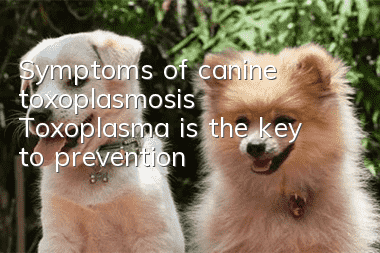Symptoms of canine toxoplasmosis Toxoplasma is the key to prevention

Toxoplasma transmission route
The causative agent of toxoplasmosis is Toxoplasma gondii, referred to as Toxoplasma gondii. It requires two hosts for its entire development. Cats are the ultimate host of Toxoplasma gondii. In the epithelial cells of the cat's small intestine, schizophrenia and gametogenesis similar to the development of coccidia are carried out. Finally, oocysts are formed and excreted with cat feces. The oocysts undergo spore proliferation and development in the external environment. An infective oocyst containing two sporangia.
Toxoplasma gondii is not selective for intermediate hosts. More than 200 species of animals, including mammals, birds, fish, reptiles and humans, are thought to be its intermediate hosts. Cats can also serve as intermediate hosts for Toxoplasma gondii. In the intermediate host, Toxoplasma gondii can reproduce asexually in nucleated cells in various tissues and organs throughout the body.
Animals become infected by eating infectious oocysts in cat feces or the meat, offal, exudates, excretions and milk of intermediate hosts containing Toxoplasma gondii tachyzoites or cysts. Tachyzoites can also infect the skin and mucous membranes, and can also infect the fetus through the placenta.
Clinical symptoms of Toxoplasma gondii
Most are asymptomatic latent infections. Infections are more common and the symptoms are more severe in puppies and young dogs, and fatal cases have also been reported in adult dogs. Symptoms are similar to canine distemper and canine infectious hepatitis. The main symptoms are fever, cough, anorexia, lethargy, weakness, secretions from the eyes and nose, pale mucous membranes, difficulty breathing, and even severe bloody diarrhea. A few sick dogs have severe vomiting, followed by paralysis and other neurological symptoms. When a pregnant female dog has a miscarriage or premature birth, the puppies often have symptoms such as loose stools, difficulty breathing, and ataxia. Blood tests show that in the acute phase, red and white blood cells are reduced and neutrophils are increased. Neutropenia and monocytosis are less common. The total number of white blood cells in chronic cases increases. Some dog selling forums warmly remind that the main symptoms are neutrophils and thrombocytopenia, but there is no bleeding tendency.
Toxoplasma laboratory examination
It is easy to confuse canine distemper, especially neurogenic canine distemper, with clinical symptoms. Therefore, after comprehensive judgment such as epidemiological analysis and clinical symptoms, it is necessary to detect the pathogen or confirm the increase in antibody titer in the serum to confirm the diagnosis.
How to prevent Toxoplasma gondii
Do not feed raw meat, prevent dogs from predating rodents, and prevent cat feces from contaminating feed and drinking water. Regular defense and deworming (Happy Brown Sugar, Golden Shield's Kexin, D-800, Australia's Byrne Insect Clear, there are also specialized zoonotic vaccines that cost about 70-80 per shot). Generally, Toxoplasma gondii and coccidia are mostly treated with one drug. Common deworming is mostly roundworms. Coccidiosis and Toxoplasma gondii need to be treated separately. Puppies are susceptible to coccidiosis, and pregnant women are particularly taboo against Toxoplasma gondii, so early treatment is recommended. Take some precautions to nip problems before they happen.
- How to feed French Dou to gain weight
- Why doesn’t the dog run away after being beaten? Don’t you want to cry after reading the answer?
- If your dog doesn’t treat you as its master, you are just a poop scooper in its eyes.
- Do dogs have double eyelids? Are dogs cuter with double eyelids?
- Dog hair care knowledge in autumn: Do this to keep your dog’s hair silky!
- Can puppies eat adult dog food? Be careful of malnutrition!
- How to tell if a wound is a dog bite? Dog bite wounds have obvious characteristics!
- Why you can’t look at dogs. Don’t look at strange dogs casually anymore!
- The dogs closely guard their twin owners and never relax for a moment
- How to treat dog beans if they occur in humans? Pay attention to treating dog beans together!



